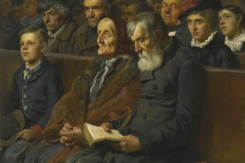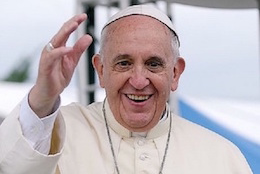A Cornish pilgrimage to Ladye Parke, Liskeard
On Sunday, on a magnificent summer's day, forty pilgrims from one end of Devon to the other end of Cornwall, gathered in Liskeard and proceeded to the west of the town and out into the country to what was in the Middle Ages a royal deer park known as Ladye Park. This place lies in a beautiful valley flanked by steep slopes covered in a variety of tall and majestic trees. A small rivulet runs through the valley. However, this was more than just a park, for in its grounds there lay a modest chapel in which as records show: "in 1378, Bishop Brantyngham granted Richard Lagge, Priest, license to say Mass in the chapel 'infra vetus parcum de Lyskerde' for the good state of King Richard. In 1441 Bp Lacy licensed two hermits and a chaplain to celebrate Divine Service three times a week, on Monday, Wednesday and Saturday."
The Parochial History of the County of Cornwall, 1870, states: ''The Chapel of Our Lady in the Park of Liskeard is often mentioned in the records of the see, and appears to have been very often frequented by devotees In it were also great oblations which had been contributed at different times'. In the 1970s, Dr Margaret Pollard (1903-1996) uncovered much evidence to suggest that pilgrimages had once centred on Ladye Park. She felt that it was Our Lady's will to 'take me back to Liskeard', and set about trying to promote the shrine, suppressed since the Reformation, by re-establishing pilgrimage of an ecumenical nature and dedicating the shrine of Our Lady of the Park for 'Unity'. In 1979, she organized the first modern pilgrimage to Ladye Park.
Attempts having been made by her to secure the site for the Church, seemed to have failed and yet, after a gap of nineteen years, a second pilgrimage ensued in 1998, and thanks to most sympathetic owners, there has been a pilgrimage during each year ever since except where a change of owners made this temporarily impossible, and even then a service of dedication was held by the new owners. What is there to see of the past at Ladye Parke?
Well, the end wall of the chapel, where the altar once stood, is still intact with a niche and one or two molded stones lie about. Built into the old farmhouse, adjoining this, may be seen remnants of mullions and an arch from the old chapel. But to visit Ladye Park is to feel the past. It is a peaceful and isolated vale with numerous water features to remind the beholder of the 'water of life'. There is the well which may well have stood at the end of the chapel. One enters the grounds by crossing a small river which runs along the outer edge of the grounds and into a small, still lake. By the entrance lies a domed, corbelled structure over the stream which clearly seems to have been the site of a baptistery.
Two weeks before the 1999 pilgrimage, the then-owner had discovered a new spring which has since been formed into a leat by the subsequent owner and runs out and over a granite outlet into the lake. This year's pilgrimage was the tenth. Several of the pilgrims arrived before Ladye Park's grounds having left the top road and descended the steep and somewhat rugged path between fields which, from mediaeval times, has been known as the 'Mass Path'. These then joined forces with the others at the end of a lane which leads to Ladye Park.
At 3pm a procession started wending its way along the valley, a 'seamless' group of Catholic and Anglican pilgrims, among them and robed up, an Orthodox priest and an Anglican canon. They sang words by Dr Margaret Pollard to the tune of 'Daily, daily, sing to Mary' as they followed behind a banner woven many years ago by Dr Pollard, and depicting the Madonna and Child. A second hymn, 'Come, O Queen, into the Garden' composed by Dr Pollard, with all its stirring seven verses and a chorus in the Cornish language, brought us all into the grounds of Ladye Park welcomed by owners, John and Judith Wilks. The sheer verdant beauty of Ladye Park on a perfect summer's day set a spiritual tone from the outset.
The pilgrims gathered in the sun to begin to pray the Rosary and individuals led a selection of five decades of 'Hail Mary's from the different mysteries, each decade chanted from different sections of the grounds: 'The Annunciation' from the centre of the large lawn, 'The Birth of Jesus' from beside the lake, 'The Baptism of Jesus from the Jordan' from the stream and baptistery, 'The Crucifixion and Death of Our Lord' by the well, and 'The Resurrection' from the site of the chapel. A charismatic group from Truro then led us in hymns of praise led by a singer/guitarist and leading on to a sharing on the theme of the Magnificat. It was notable that among the pilgrims and prayer leaders there was an impressive cross section of people and ages, as many young as old, and all clearly moved by the occasion. Having attained to the spiritual heights, we were gently brought down to the material earth by a splendid and generous array of coffee, cakes and a cream tea which permitted us to wind down in good company with pleasant conversation.
The proceedings were brought to an end by a blessing in the form of 'Nunc Dimittis' from our Orthodox priest and friend, and, fittingly, on this the tenth pilgrimage in what is a particularly Cornish, Marian setting, with the 'Our Father' (Pader Agan Arloedh) and 'Hail Mary' (Hayl Maria) said in Cornish by one of the company. Philip Knight, is a parishioner of the Church of the Immaculate Conception, Penzance


















